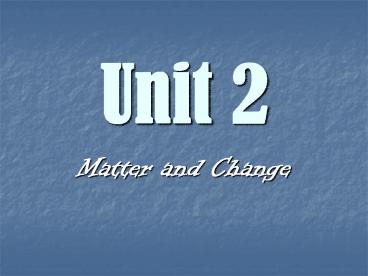Matter and Change - PowerPoint PPT Presentation
1 / 17
Title: Matter and Change
1
Unit 2
- Matter and Change
2
Obj. 11-13Separation of Matter
- Elements are the purest substances on earththey
cannot be broken down any further. - Compounds are formed by chemically bonding two or
more elements together. - must be chemically separated (reactions).
- Mixtures are formed by physically combining two
or more pure substances together. - can be physically separated.
- Mixtures are separated by their physical
properties. - boiling point, density, solubility etc
3
Obj. 11-13 cont
- How could you separate a mixture of sand and
salt? - dissolve salt in water and filter out the
sand. - separation based on solubility!
- How could you separate a mix of iodine and iron
filings? - use a magnet to pull out the iron filings.
- separation based on magnetism!
4
Obj. 11-13 cont
- Four methods of separation of mixtures
- Distillation
- Exmixture of alcohol (BP 78.5C) and water (BP
100C)
separates a mixture of liquids based on different
boiling points.
5
Obj. 11-13 cont
- Filtration
- Exa sand and salt mixture
separates two solids based on their solubility
(ability to dissolve) in different solvents.
6
Obj. 11-13 cont
- Centrifugation
separates substances based on the density of the
particles in the mixture.
- Exblood components, proteins in milk,
precipitate in a liquid
7
Obj. 11-13 cont
- Chromatography
- Ex pigments in ink, pigments in chlorophyll
separates based on the absorption of the
substances in the mixture.
8
Obj. 14Physical vs. Chemical Properties
- Physical propertiescan be observed w/out
changing the substance. - Ex
- color
- density
- texture
- size
- boiling/melting point
- solubility
- magnetism
9
Obj. 14 cont
- Chemical propertiesproperties that explain how a
substance will react or behave.
- Ex
reactivity to
? water
? acids
? bases
flammability
ability to be oxidized (lose e-)
10
Obj. 15Physical vs. Chemical Changes
- Physical changeschanges in appearance onlyNOT
chemical make-up.
- Evidence of physical changes...
color change (if same substance)
change in shape
change in temp. (manually heating and cooling)
change in size
change in phase
11
Obj. 15 cont
- Examples of physical changes...
breaking a window
tearing / cutting a piece of paper
melting a piece of ice
12
Obj. 15 cont
- Chemical changeschanges result in a
re-arrangement or
recombination of atoms
(NEW substance!).
cant get original substance back w/out chem.
rxn.
- Evidence of chemical changes...
gas / bubbles given off
formation of precipitate
heat given off / absorbed (breaking/making
chem. bonds)
light given off
color change (if new substance)
13
Obj. 15 cont
- Examples of chemical changes...
silver tarnishing
a nail rusting
burning a match
food rotting/souring
baking bread
14
Obj. 16Law of Conservation of Mass
- matter cannot be created or destroyed
- total mass on reactant side MUST mass on
product side.
what goes into the rxn. must come out!
- Ex
A B C D
8 grams
11 grams
5 grams
2 grams
_________
13 grams
15
Obj. 17-18Density
- Densityamount of matter present in a given
volume.
how heavy a substance is
- D m/v
- units g/ml or g/cm3
16
Obj. 17-18 cont
- Density problems
1. A nail has a vol. of 0.880 cm3 and a mass of
6.920 grams.
What is the density of the nail?
D 7.86 g/cm3
D m/v
D 6.920 g / 0.880 cm3
2. Vegetable oil has a density of 0.916 g/ml.
Calculate the
mass of 500.0 ml of oil.
m D(v)
m 0.916 g/ml (500.0 ml)
m 458 grams
3. The density of a piece of wood is 0.86 g/cm3.
What is the
volume of the wood if its mass is 75 grams?
v m/D
v 75 g 0.86 g/cm3
v 87 cm3
17
Obj. 17-18 cont
- To calculate density of an object
find mass of object using balance
find vol. of object by using the water
displacement
method
water displacement will not work if solid
dissolves or floats in water.































